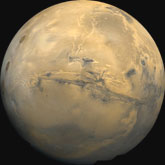Exploring The 'Red Planet'
 The planet Mars, sometimes called the 'Red Planet', has been an object of study for many centuries. The distinctive reddish color of the planet led some cultures to associate Mars with bloodshed and war. The Babylonians, for example, called Mars Nergal, the 'King of Conflicts'. The Greeks named it Ares after their god of war, while to the Romans, it was Mars. The Egyptians knew it as the 'Red One'. Credit should also be given to the Egyptian astronomers for beginning the exploration of Mars by noting that most stars stay in fixed positions but certain stars, like the 'Red One', move. There was something different about these moving stars but it would take many centuries and the invention of the telescope before Mars became more than just a moving star-like point of reddish light in the sky.
The planet Mars, sometimes called the 'Red Planet', has been an object of study for many centuries. The distinctive reddish color of the planet led some cultures to associate Mars with bloodshed and war. The Babylonians, for example, called Mars Nergal, the 'King of Conflicts'. The Greeks named it Ares after their god of war, while to the Romans, it was Mars. The Egyptians knew it as the 'Red One'. Credit should also be given to the Egyptian astronomers for beginning the exploration of Mars by noting that most stars stay in fixed positions but certain stars, like the 'Red One', move. There was something different about these moving stars but it would take many centuries and the invention of the telescope before Mars became more than just a moving star-like point of reddish light in the sky.
Between the 15th and 19th centuries, the observations made by astronomers shaped our perception of the 'Red Planet'. Using observational data of Mars from Tycho Brahe, Johannes Kepler determined his three laws of planetary motion, while at nearly the same time, Galileo used the newly invented telescope to become the first to observe a planet with more than the unaided eye. Over the course of the next few centuries, the observation of Mars continued as telescopes became larger and better. Sketches made from observations showed that Mars had light and dark colored regions and that it was a dry, arid-looking planet with ice at the poles that changed in size as seasons came and went. Despite the improvements made in telescopes, it was still difficult to see the surface clearly, and it was this problem that in part led to the notion that there were irrigation canals dug by Martians to bring water from the melting polar ice to their cities, crossing the planet.
The perception of Mars as a desert planet with a dying or dead civilization provided great fuel for science fiction and led to much speculation about what Mars looks like. Until 1965, nobody had seen the surface clearly enough to say what it really was like and it wasn't until the Mariner 4 flyby mission that, for the first time, we were finally able to see the surface of Mars. And from those 21 images, we saw that there were no irrigation canals or evidence of Martian civilizations. In fact, the first impression was that Mars looked like the moon. However, unlike the moon, Mars has an atmosphere and that is a big difference. The Martian surface continuously changes as mountains and crater walls are weathered from wind-blown sands. And as we continued exploring Mars during the 1970s and 1990s, our perception and understanding of Mars has changed; however, it will never be as dramatic as the first time we all had a look at Mars and saw what it really looked like.
About the Author
Bob Riddle
 Bob Riddle lives in Lee's Summit Missouri and is adjunct faculty at Longview
Community College and Avila University where he teaches Astronomy and
Physical Science in the clasroom as well as online. He maintains 'Que tal in the Current Skies', an Astronomy website, and is the column editor for 'Scope on the Skies', a regular feature of Science Scope Magazine, the National Science Teachers Association middle school journal.
Bob Riddle lives in Lee's Summit Missouri and is adjunct faculty at Longview
Community College and Avila University where he teaches Astronomy and
Physical Science in the clasroom as well as online. He maintains 'Que tal in the Current Skies', an Astronomy website, and is the column editor for 'Scope on the Skies', a regular feature of Science Scope Magazine, the National Science Teachers Association middle school journal.


